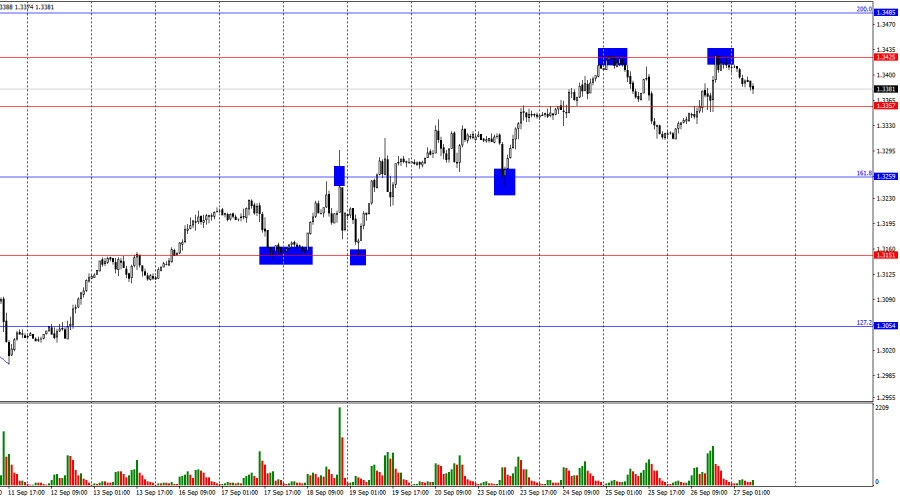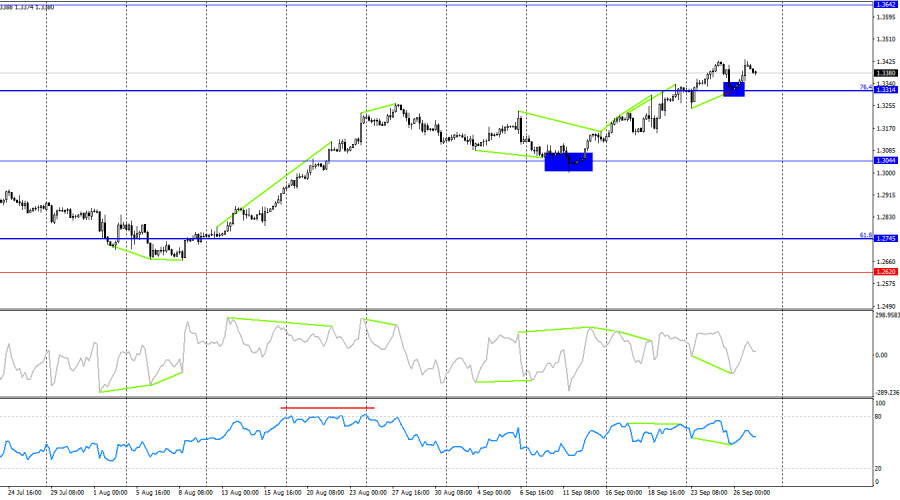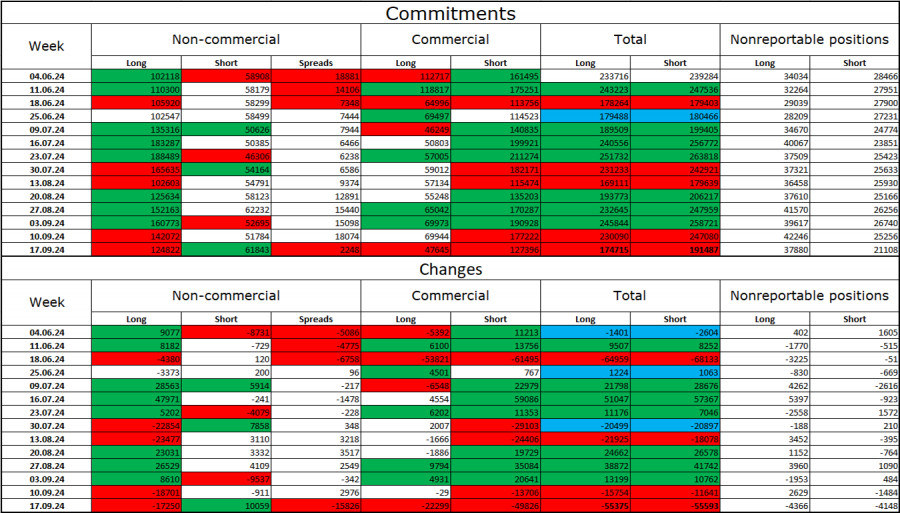
On the hourly chart, the GBP/USD pair on Thursday returned to the 1.3425 level and rebounded from this level for the second time. A reversal in favor of the dollar occurred, and the decline may continue toward the recent low of 1.3311. The pound remains overbought, and yesterday's news did not suggest a new wave of bullish attacks. However, the bulls continue their offensive, and the bears have nothing to counter them. Therefore, another increase in the pound is possible.

The wave pattern is clear. The last completed wave down (from September 6–11) broke the low of the previous wave, and the wave that has been forming over the past few weeks has broken the high of the previous wave at 1.3234. As a result, the "bearish" trend ended before it even began. At least for now, there are no signs of even a sideways movement that could provide support for the U.S. currency. To reverse the current "bullish" trend, a decline of 340-360 points is required.
On Thursday, the news did everything possible to support the American currency. The U.S. GDP grew by 3% in the second quarter, as expected, and the first-quarter figure was revised from 1.4% to 1.6%. Thus, the U.S. economy grew more strongly in the first half of the year than traders anticipated. Orders for durable goods showed no change (0.0% m/m), although traders expected a drop of 2.6%. Therefore, the actual data significantly exceeded forecasts. However, even these two undoubtedly important reports had no impact on the pair's movement. The dollar didn't even attempt to grow, and the bears didn't try to launch an attack. Today, we expect the important PCE Index, which reflects changes in core consumer expenditure. The Fed uses this index to gauge inflation trends.

On the 4-hour chart, the pair rebounded from the 76.4% corrective level at 1.3314. Another reversal occurred in favor of the pound, with growth resuming toward the next level at 1.3642. The RSI and CCI indicators have formed "bullish" divergences, which increase the likelihood of further growth. However, consolidation below the 1.3314 level could mark the beginning of a new "bearish" trend.
Commitment of Traders (COT) Report

The sentiment of non-commercial traders has become much less bullish over the last reporting week. The number of long positions held by speculators decreased by 17,250, while short positions increased by 10,059. Thus, for the second consecutive week, professional traders have been reducing long positions and increasing shorts. The pound, however, has barely fallen during this time, suggesting a potential drop. The bulls still have a solid advantage, with a gap between long and short positions of 63,000: 125,000 against 62,000.
In my view, the pound still has prospects for a decline, but the COT reports currently suggest otherwise. Over the last three months, the number of long positions has grown from 102,000 to 125,000, while the number of shorts has increased from 58,000 to 62,000. I believe that over time, professional traders will either reduce their long positions or increase their shorts, as all possible factors favoring pound purchases have already been accounted for. However, graphical analysis currently points to a "bullish" trend.
Economic Calendar for the US and UK:
USA – Core Personal Consumption Expenditures (PCE) Index (12:30 UTC)USA – Personal Income and Expenditures (12:30 UTC)USA – University of Michigan Consumer Sentiment Index (14:00 UTC)On Friday, the economic calendar contains at least three important entries. The impact of the news on market sentiment for the rest of the day is expected to be moderate.
Forecast for GBP/USD and Trading Tips
Selling the pair was possible when it rebounded from the 1.3425 level on the hourly chart, with targets at 1.3357 and 1.3259. These trades can remain open for now. New buy opportunities were considered if the pair closed above 1.3357 on the hourly chart, with targets at 1.3425 and 1.3485. The first target was reached. New buys can be considered upon another rebound from the 1.3357 level or if it closes above 1.3425.
Fibonacci levels are plotted based on 1.2892–1.2298 on the hourly chart and 1.4248–1.0404 on the 4-hour chart.